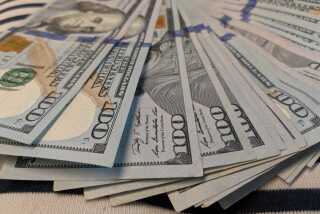Foreign Bond Funds May Be Investor Plums
- Share via
The suddenly weak dollar could be a disaster for American tourists going abroad this summer, but if you’re an investor, it spells opportunity.
By Friday of last week, the number of Swiss francs that a dollar could buy had dropped to 1.46 from 1.49 last Monday. In French francs, the dollar fell to 5.40 from 5.44. And in Japanese yen, the dollar was worth 127.60, down from 129.30.
Those are relatively small moves, to be sure, but the trend is what’s important: Traditionally, this is the time of year when the dollar begins to slide.
If that cycle is unfolding again, now is the time for American investors to buy shares of mutual funds that own foreign stocks or bonds--because those funds could automatically rise in value if foreign currencies get stronger.
The pattern of dollar strength in the first half of the year followed by weakness in the second half has played out in each of the last five years. Experts aren’t sure why.
Most economists believe that the dollar rises early in the year because January typically brings with it revived optimism about economic growth in the United States. Also, American pension funds tend to get large capital inflows at the start of each year--money for future pensioners--that must be invested for the most part in U.S. stocks and bonds.
By the second half of the year, both trends often reverse. The economy doesn’t live up to earlier expectations, and capital flows into big investors decline.
The dollar is pushed and pulled by the trends because the value of a nation’s currency is almost always a reflection of the perceived vitality of its economy and markets. The countries that boast the best economic prospects usually attract more capital from investors worldwide. Also, when a country’s stocks or bonds are in demand, by definition its currency must be in demand as well.
How does all of this translate into opportunity for the average investor? Foreign bond mutual funds provide a good illustration:
* Foreign bond funds generally own government bonds issued by major nations around the globe. In recent years, the yields on the bonds have typically been well above what the U.S. government pays on its bonds. Many foreign bond funds still sport yields of 7% to 9%, while the typical fund that owns U.S. Treasury bonds yields around 6.5%.
* Unlike U.S. Treasury bond funds, however, foreign bond funds have currency risk : If the currencies of the countries whose bonds you own weaken versus the dollar, the share value of your investment can fall, reducing your total return.
* If, on the other hand, foreign currencies gain in value against the dollar, foreign bond fund owners can see the value of their shares advance too.
In the first five months of this year, the dollar rose almost on seasonal cue, and foreign bond fund owners suffered. A U.S. investor in German bonds, for example, on paper lost 3.42% of his investment between Jan. 1 and Friday, as measured by a Salomon Bros. index of German bonds.
Though long-term German government bonds pay annual interest of about 8%, the interest you earned in the first five months was more than offset by a drop in the value of the bonds themselves--because the dollar’s value rose from 1.52 German marks on Jan. 1 to 1.67 marks by mid-April.
Now, however, the dollar is already back down to 1.61 marks. If it continues to head lower between now and the end of the year, the math will work in foreign-bond fund owners’ favor: You would not only get your interest earnings but a capital gain as well.
The big question is whether the dollar will follow the usual seasonal script. This year, many experts doubt it.
Last week’s dollar weakness was engineered by the Bank of Japan, which is trying to bolster the yen for political purposes. But many dollar watchers argue that Japan is fighting a losing battle, and that the dollar should remain strong through the end of ’92.
Les Nanberg, who manages the $310-million MFS Worldwide Government Trust bond fund in Boston, says confidence in the dollar stems mostly from expectations that the U.S. recovery is gaining steam, while Germany, Japan and other major competitors languish in or near recession.
“Our guess is that the U.S. will be one of the few economies that’s growing, so we’d be surprised to see much dollar weakness from here,” Nanberg says.
Likewise, the conventional wisdom sees U.S. interest rates rising by year’s end with the stronger economy, while many foreign nations appear to have plenty of room to reduce their high rates further. If that happens, money would be expected to flow into U.S. bonds, thus supporting the dollar.
Still, some bond experts say there are chinks in the dollar’s armor, suggesting foreign bond funds may indeed shine over the next seven months:
* Ross Perot’s independent presidential bid could bust the dollar by sowing confusion. Financial markets today assume that George Bush will be reelected. “Any other candidate (in the lead) would naturally throw up a great deal of uncertainty,” notes Mark Turner, manager of the Scudder International Bond fund in Boston.
If the race breaks wide open--or the election winds up in the House of Representatives--the dollar could suffer mightily as foreign investors either pull money out or decline to invest more.
* The dollar may not gain even if foreign interest rates fall. Keith Gardner, analyst with the T. Rowe Price International Bond fund in Baltimore, points out that the dollar has weakened lately even as many European countries except Germany have cut interest rates.
More surprising, he notes, is that analysts had figured that France, Britain and other European nations couldn’t cut their rates until Germany did. “This seems to prove that there’s no reason (other European) rates can’t be lower than Germany’s,” Gardner says.
Where’s the profit opportunity for American investors? If foreign interest rates continue to fall, owners of foreign bonds will reap a capital gain as their older, higher-yielding bonds become more valuable compared to the new, lower yields. Only a rising dollar could offset that gain; a falling dollar would add to it.
* If U.S. interest rates don’t rise as expected, foreign bonds will look much better. John Lipsky, economist at Salomon Bros., believes that too many investors are already convinced that long-term U.S. rates must rise with the economic recovery. The surprise may be that the economy remains weak enough to allow rates to fall further this year, he says.
Should U.S. rates just stay stable, yields on many foreign bonds are so high compared to U.S. yields that investors will increasingly see the advantage in holding foreign bonds, some experts contend.
Britain, for example, now pays 9.03% on its five-year bonds; in contrast, five-year U.S. Treasury notes pay 6.61%. Even if British rates continue to fall, they have a long way to go before their advantage over U.S. rates disappears.
If you don’t especially want to weigh all these factors, there’s one last reason to consider owning foreign bonds: They’re a hedge in case the high-flying U.S. stock market takes a tumble--as in the fall of ’87 and summer of ’90.
If something goes terribly wrong with U.S. stocks, the dollar would naturally suffer as well. An investment in foreign bonds could offset at least some of the losses on your stocks in that situation, because foreign currencies should gain at the dollar’s expense.
“The best reason for foreign-currency diversification is the height of the stock market,” argues Don Gould, who manages the Huntington Advisers International Cash portfolios in Pasadena.
The Dollar’s Annual Pattern
Since 1987, the dollar’s value against major foreign currencies has tracked a similar pattern each year. The dollar rises or at least remains level in the first half of the year, then declines in the second half. If that pattern holds, it could be a smart time to buy foreign securities, including foreign-bond mutual funds.
Source: Morgan Guaranty
More to Read
Inside the business of entertainment
The Wide Shot brings you news, analysis and insights on everything from streaming wars to production — and what it all means for the future.
You may occasionally receive promotional content from the Los Angeles Times.










